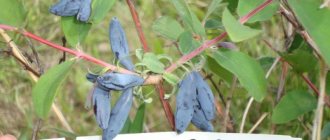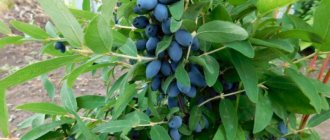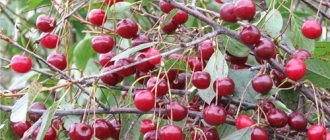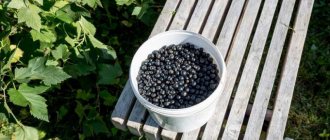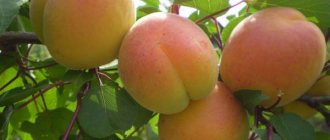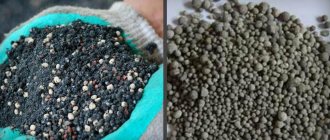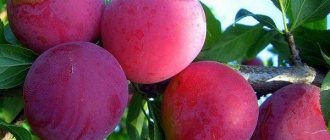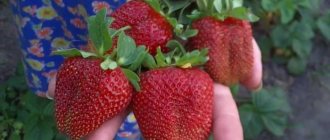Honeysuckle is a valuable berry; it is useful for hypertensive patients, as it lowers blood pressure. Until 2000, there were practically no sweet varieties in Russia; the situation was corrected by scientists from the Federal State Unitary Enterprise Bakcharskoe. They have developed several varieties of honeysuckle with excellent taste and enviable characteristics that have received worldwide recognition, while breeders from other countries have been left behind.
The most popular honeysuckle in Russia remains the Pride of Bakchara; it was included in the State Register in 2007.
Description of the honeysuckle variety Pride of Bakchara
Pride of Bakchar - this is the name of the giant berry, which is gaining popularity especially in cold regions. Good fruiting, ease of care, tasty and healthy fruits are the reasons that this variety of honeysuckle is one of the favorites of many gardeners.
Did you know? Not only the fruits of edible honeysuckle, but also its flowers have beneficial properties.
Honeysuckle flowers, in particular, decoctions and infusions of them are used in folk medicine to treat inflammatory processes, relieve fever, remove toxins, and as antiseptic and disinfectant measures.
Below is a description of the external characteristics of the variety:
- the height of an adult medium-sized bush is about 1.6 m, diameter is up to 1.2 m;
- the crown of the plant is of medium density, stack-shaped;
- shoots are long, curved, light brown in color;
- skeletal branches are arched, brown in color;
- the flowers are bell-shaped, yellow-green;
- The fruits are very large, purple in color.
From afar, the spreading bush of Bakchar's Pride resembles a haystack. The branches can grow chaotically, “sloppy”: some are directed upward, others lean down, so this specimen is unlikely to look harmonious as an element of garden design. But it is ideal as a source of large, sweet berries.
History of selection
This large-fruited variety was developed relatively recently. In 2006, an entry was made into the State Register of Breeding Achievements about the new variety Pride of Bakchara under the authorship of I. Gidzyuk, N. Savinkova, A. Tkacheva and A. Pavlovskaya. The originator is the Federal State Unitary Enterprise "Bakcharskoye" of the Tomsk region. By origin, this is a seedling from free pollination of the elite form of honeysuckle Turchaninov.
Appearance, characteristics of berries, ripening time, yield
The undeniable pride of this shrub is its fruits - few varieties can boast of berries measuring up to 5 cm in length and an average weight of 1.7 g. They resemble a curved spindle in shape. The color is blue-violet, covered with a strong waxy coating. The chemical composition of berries includes sugar (about 6.5%), acids (2.6%), and they are also rich in vitamin C (35 mg per 100 g).
Important! Berries that have reached ripeness should be picked immediately, otherwise they will quickly crumble. Collection is easy by shaking the bushes. Place a piece of cellophane under the bush to collect ripened berries, and collect those that remain on the bush to ripen next time.
The fruit pulp is dense, medium juicy, has a sweet and sour taste, without pronounced bitterness. These dessert berries have virtually no flavor. On a five-point taste rating scale, professional tasters assigned them a value of 4.8 points, and in processed products - 4.9 points.
The honeysuckle bush begins to bear its first harvest approximately in the 5th year after planting, and in the 8th–10th year of life the average yield is 2.8 kg per bush, the maximum is 3.6 kg. Ripening is medium late, harvest can be expected in mid-July.
Advantages and disadvantages of the variety
- Amateurs and professionals who grow the Pride of Bakchar variety highlight a number of its advantages:
- high productivity;
- large fruit;
- ease of picking, keeping quality and transportability of berries;
- increased frost resistance;
- resistance to diseases and insect pests;
- comparatively unpretentious in care.
- Among the disadvantages of the variety, according to gardeners, are:
- self-sterility (for its pollination and fruiting, other types of honeysuckle must grow nearby);
- low pollination (flowers often cannot withstand the heavy weight of insects);
- high crumbling;
- the variety is not particularly decorative.
Varietal characteristics
Honeysuckle “Pride of Bakchar” was bred by breeders of the Federal State Unitary Enterprise “Bakcharskoye”. If we talk about the shape of the bush, it resembles a stack of medium height. The branches are not located in the same tension - some grow upward, some fall, bend, like a willow tree. Not all summer residents like spreading bushes, so not everyone chooses this variety for landscape decoration. But the fruits of this honeysuckle are quite good, although they have a bitter taste. In more detail, we will get acquainted with the description below.
Varietal characteristics. "Bakchar's Pride":
- large-fruited shrub - fruit length reaches up to 5 cm, width - up to 1.5 cm, weight - up to 3 grams;
- the shape of the berry resembles a month;
- The fruits ripen closer to the third ten days of July, so this is more of a late variety;
- minus – high shedding of ripe honeysuckle. The collection must be carried out regularly;
- the color of the skin is blue-violet, there is a strong white coating;
- the taste is both sweet and sour, pleasant, but there is a bitterness. Taster rating is 4.8 out of 5 points;
- productive honeysuckle - up to 3.6-4 kg per bush. One hectare of plantings will bring up to 10.5 tons;
- grows up to 1.6 meters, in diameter can reach 120 cm;
- some of the branches are strong and do not bend, while others bend under the weight of their own harvest;
- edible honeysuckle pride “Bakchara” has a dessert purpose;
- well stored and easily transported, can be grown for sale;
- pollinator varieties are required;
- the berries can be frozen, made into jam, jam, compote, jam;
- is not afraid of cold weather, diseases, or insects. Seedlings are not afraid of return frosts down to -8 degrees;
- The advantage of this variety is that the crop can be harvested either manually or using machinery.
On a note! Experience has shown that honeysuckle is bitter if it grew in the sun and received little water. With sufficient moisture, the fruits are more tasty, and the percentage of vitamin C in them increases.
As you can see, there are many pros, few cons. We must also tell you that if you decide to plant this variety in your dacha, then do not forget to purchase pollinator seedlings. We have already mentioned this above in the description of the honeysuckle variety “Pride of Bakchar”. This could be “The Giant’s Daughter”, “Strezhevchanka”, “Delight”, “Bakcharsky Giant”.
Agricultural technology
Despite the fact that the plant is not too capricious, there are some subtleties in the process of planting and caring for it.
Selecting a location
It is recommended to choose a sunny place for planting. Honeysuckle will also grow in the shade, but will produce better yields in a sunny area. It would be good to ensure the area with bushes is ventilated, but do not overdo it with strong drafts. Wetlands should not even be considered when planting.
Learn how to grow Omega and Julia honeysuckle varieties.
But honeysuckle does not like extremes: in dry soil the plant will simply dry out. It is necessary to maintain the necessary balance of sun and moisture, then the taste of the berries will be sweet, without bitterness. The best green neighbors for Pride of Bakchar will be other varieties of honeysuckle, thanks to which it will be pollinated.
Planting and care
The best time to plant edible honeysuckle is from late summer to early November. At this time, bushes with an open root system are planted. If you decide to plant a plant in the spring, then you need to do this as early as possible, before the buds open. Pride of Bakchar requires stable average soil moisture. The ideal option is loose soil with an acidity of 7.5–8.5, well saturated with organic fertilizers.
Here is a general landing algorithm:
- Dig a hole up to 40 cm deep and the same in diameter. These are approximate sizes, be guided by the size of the seedling.
- Place a 5-centimeter drainage layer of stones or broken bricks at the bottom of the hole.
- Add 1 bucket of compost, 1 liter jar of wood ash and about 30 g of superphosphate on top.
- Stir, add 1 bucket of water and leave the fertile mixture to settle.
- Then form a mound in the center of the hole, place the seedling on it, carefully straighten the roots and sprinkle with loose soil.
- Compact the soil around the seedling and water generously.
- Cover the soil with organic mulch to prevent moisture loss.
Caring for honeysuckle is not difficult. It is enough to regularly water abundantly (especially in hot summer), loosen the soil, trim bushes, weed unwanted plants, and renew the mulch. Since you added a sufficient amount of fertilizer when planting, you don’t have to feed the bush for two years. Then, for feeding in the spring, organic fertilizers (compost, humus) are best suited, and in late summer and early autumn - a mixture of 0.5 liters of wood ash plus 2 tbsp. l. superphosphate.
Did you know? If you water a honeysuckle bush with hot water up to 60°C in early spring, this will help the plant’s buds “awaken” and destroy pests and fungal spores that have overwintered there.
During the flowering period, mineral mixtures are added to each bush. Complex preparations containing nitrogen, potassium and phosphorus are used dry or dissolved in water. Root feeding is possible, as well as spraying the bush. A urea solution (1 tbsp per bucket of water) is suitable for spraying.
Features of pollination
Pride of Bakchar does not apply to plants that can bear fruit on their own. Honeysuckle varieties cross-pollinate, so it is recommended to plant several different inter-pollinating honeysuckle varieties at intervals of 1.5 m from each other. The varieties Silginka, Blue Spindle, Blue Bird, Daughter of the Giant, and Bakcharsky Giant are considered the best pollinators.
Disease and pest control
Despite the disease resistance, there is a possibility of honeysuckle becoming infected with a fungal disease. This is easy to recognize by the appearance of rot, brown spots on the leaves, and a white coating on the underside of the leaves. To prevent such diseases in early spring, spray with a solution of 10 liters of water, 1 tbsp. l. shavings of laundry soap and 10 g of copper sulfate. The drug “Fundazol” is also used for these purposes.
Important! During the ripening of the crop, pesticides cannot be used to control pests, so it is better to give preference to bioinsecticidal preparations that do not contain poisons, or folk remedies - spraying the tops of tomatoes or potatoes with infusion, for example.
Well, wood ash, colloidal sulfur or Topaz fungicide will help fight an already attacking disease, for example, powdery mildew. Bakchar's pride can be attacked by insects such as aphids, scale insects, leaf roller caterpillars, and honeysuckle mites. They harm young shoots and leaves. The drugs “Rogor”, “Inta-Vir”, “Confidor”, “Mavrik”, etc. will help fight these pests.
Pruning and crown formation
In autumn or early spring, sanitary pruning of broken, dried, weak or diseased branches is carried out. It is not recommended to get too carried away and cut off the ends of healthy shoots, so as not to accidentally get rid of flower buds. From the age of 6, it is necessary to carry out regular anti-aging pruning of the bush: old, worn-out branches are cut off completely. Usually 5–6 of the strongest branches remain, which subsequently produce a good harvest.
Wintering
Pride of Bakchar tolerates low temperatures well, and even blossoming flowers are not afraid of return frosts. But it’s still worth helping the plant prepare for winter. To do this, before the first frost, water the soil generously, since then it will no longer be possible to irrigate the bush. Young immature seedlings can be covered with agrofibre. But it is not necessary to cover adult shrubs for the winter.
We grow wonderful shrubs on the site
Selection of location
As we have already said, this variety falls apart, if you don’t like it, then don’t make decoration your goal. The place should be sunny, which is important for any honeysuckle. It should be moderately humid, but not damp. We remember that light and good moisture as needed result in a tasty berry without bitterness and high quality. There should be enough space for both the “Pride of Bakchar” itself and its pollinators, while ensuring that no one interferes with each other - a minimum distance of 1.5 meters.
Planting can be done from autumn to spring, if the seedling was purchased in a pot; if with bare roots, then optimally - the end of August and September. Before planting, the area is dug up, ash is added, and weeds are removed. This variety prefers slightly alkaline and neutral soils that are well-permeable to air.
Important! Do not plant honeysuckle “Pride of Bakchar” where it is windy or in areas with high traffic. We remember about strong crumbling.
Feeding and planting
We dig holes about 50 cm wide and 35 cm deep, but again we focus on seedlings. Here we put 3-5 kg of rotted manure, the soil that was dug out of the hole, mixed with 50 grams of potassium salt. We lay drainage at the bottom of the hole - sand or broken brick. We place the seedling in the hole, the root collar should be flush with the ground. We bury the honeysuckle, compact it and water it, shorten the branches by a third of the length. Then we lay out mulch - for the summer it can be decorative colored sawdust, straw, for the winter, rotted manure, spruce branches, peat.
Seedling care
There is no need to apply fertilizers for the first two years. You only have to water the area, loosen it, and remove weeds. In the spring, carry out sanitary pruning of all bad branches. When the shrub reaches the age of 6-8 years, rejuvenating pruning is done every year, removing all old trunks and shoots, allowing about five strong branches to grow. From the age of 3-4 years, feeding is carried out 2 times with organic matter per season - after awakening in the spring, and then after fruiting and with mineral preparations during flowering. Thus, you can grow honeysuckle pride of Bakchar without spending time, effort, or money.
Advice! Choose feeding preparations that are based on biological substances. Markings can be seen on the packaging. Such supplements are safe for health.
If you have never grown honeysuckle, then we recommend that you plant it in the new season. The berry is really very healthy and worthy of your attention.
Harvesting and transportation, keeping quality of berries
Harvesting of this variety is mid-late, starting around mid-July. The fruits are easy to transport due to their very thick skin. Keeps in the refrigerator for up to 7 days. Large sweet berries can be eaten fresh, or they can be dried, frozen, prepared in the form of jam, raw jams, compotes, infusions, decoctions, and even homemade wine.
Honeysuckle berries will help you compensate for the lack of vitamins and microelements. One cannot fail to mention their medicinal properties. They have diuretic, choleretic, anti-inflammatory and disinfectant properties. Also, consuming honeysuckle is useful for strengthening the cardiovascular system and has a good effect on the overall tone of the body.
Honeysuckle Pride of Bakchar has gained popularity and good reviews from gardeners. Thanks to the ease of care, unpretentiousness, and versatility of dessert berries, this variety will take its rightful place in your country plot.
Secrets of cultivation
There are no special secrets in growing blue honeysuckle Pride of Bakchar. There are only nuances characteristic of the variety.
Landing dates
Honeysuckle seedlings can be planted in spring and autumn. In summer, layering is done from an adult bush. When planting in spring, seedlings must be planted before the buds open. May - it's already late. At this time, the bush rapidly begins to develop shoots. The optimal planting time is autumn. Honeysuckle seedlings begin to be planted from September to the third ten days of October.
Selection of location and soil
Honeysuckle is an unpretentious plant, but to obtain a good yield, you need to choose a place on the site that is comfortable for the bushes and prepare the soil. Select a site taking into account the following rules:
- protection from drafts, but good ventilation of the area is desirable;
- the height of the groundwater layers is not higher than 1 m;
- the soil is not acidic, more neutral, constantly moist and preferably without large admixtures of sand.
Reviews
I tried Bakchar's Pride today. The first berries have been hanging for 2 weeks, they have acquired sugar, the sourness is completely gone. Large sweet berries with thin skin, juicy, but no aroma, the taste is “nothing.” Having tried this variety before purchasing, I would not buy it. Although after the sugar has accumulated and the sourness has gone, you can of course eat whole handfuls of the berries. Most Germans would probably even like it, we now have in fashion varieties of fruits without sourness and without aroma, just juicy and light sugar. The last week was mostly cloudy, the previous week was very sunny.
Bavarian
https://forum.vinograd.info/showpost.php?s=6b593d37821cd10305c04c1957b34e7d&p=1452113&postcount=10
